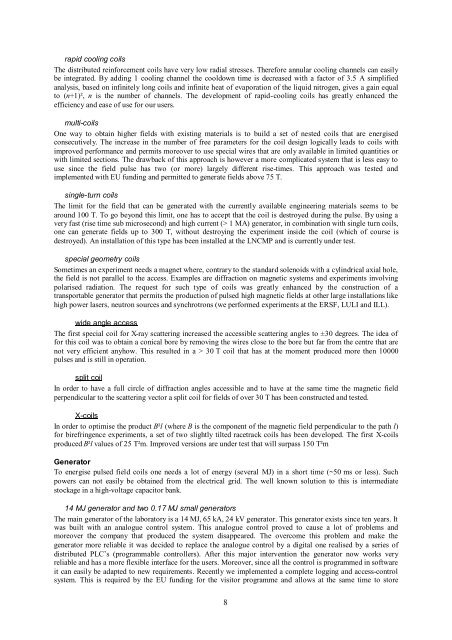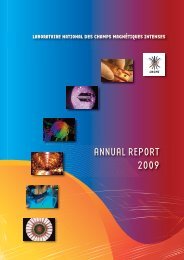Laboratoire National des Champs Magnétiques Pulsés CNRS – INSA
Laboratoire National des Champs Magnétiques Pulsés CNRS – INSA
Laboratoire National des Champs Magnétiques Pulsés CNRS – INSA
You also want an ePaper? Increase the reach of your titles
YUMPU automatically turns print PDFs into web optimized ePapers that Google loves.
apid cooling coils<br />
The distributed reinforcement coils have very low radial stresses. Therefore annular cooling channels can easily<br />
be integrated. By adding 1 cooling channel the cooldown time is decreased with a factor of 3.5 A simplified<br />
analysis, based on infinitely long coils and infinite heat of evaporation of the liquid nitrogen, gives a gain equal<br />
to (n+1)², n is the number of channels. The development of rapid-cooling coils has greatly enhanced the<br />
efficiency and ease of use for our users.<br />
multi-coils<br />
One way to obtain higher fields with existing materials is to build a set of nested coils that are energised<br />
consecutively. The increase in the number of free parameters for the coil <strong>des</strong>ign logically leads to coils with<br />
improved performance and permits moreover to use special wires that are only available in limited quantities or<br />
with limited sections. The drawback of this approach is however a more complicated system that is less easy to<br />
use since the field pulse has two (or more) largely different rise-times. This approach was tested and<br />
implemented with EU funding and permitted to generate fields above 75 T.<br />
single-turn coils<br />
The limit for the field that can be generated with the currently available engineering materials seems to be<br />
around 100 T. To go beyond this limit, one has to accept that the coil is <strong>des</strong>troyed during the pulse. By using a<br />
very fast (rise time sub microsecond) and high current (> 1 MA) generator, in combination with single turn coils,<br />
one can generate fields up to 300 T, without <strong>des</strong>troying the experiment inside the coil (which of course is<br />
<strong>des</strong>troyed). An installation of this type has been installed at the LNCMP and is currently under test.<br />
special geometry coils<br />
Sometimes an experiment needs a magnet where, contrary to the standard solenoids with a cylindrical axial hole,<br />
the field is not parallel to the access. Examples are diffraction on magnetic systems and experiments involving<br />
polarised radiation. The request for such type of coils was greatly enhanced by the construction of a<br />
transportable generator that permits the production of pulsed high magnetic fields at other large installations like<br />
high power lasers, neutron sources and synchrotrons (we performed experiments at the ERSF, LULI and ILL).<br />
wide angle access<br />
The first special coil for X-ray scattering increased the accessible scattering angles to ±30 degrees. The idea of<br />
for this coil was to obtain a conical bore by removing the wires close to the bore but far from the centre that are<br />
not very efficient anyhow. This resulted in a > 30 T coil that has at the moment produced more then 10000<br />
pulses and is still in operation.<br />
split coil<br />
In order to have a full circle of diffraction angles accessible and to have at the same time the magnetic field<br />
perpendicular to the scattering vector a split coil for fields of over 30 T has been constructed and tested.<br />
X-coils<br />
In order to optimise the product B²l (where B is the component of the magnetic field perpendicular to the path l)<br />
for birefringence experiments, a set of two slightly tilted racetrack coils has been developed. The first X-coils<br />
produced B²l values of 25 T²m. Improved versions are under test that will surpass 150 T²m<br />
Generator<br />
To energise pulsed field coils one needs a lot of energy (several MJ) in a short time (~50 ms or less). Such<br />
powers can not easily be obtained from the electrical grid. The well known solution to this is intermediate<br />
stockage in a high-voltage capacitor bank.<br />
14 MJ generator and two 0.17 MJ small generators<br />
The main generator of the laboratory is a 14 MJ, 65 kA, 24 kV generator. This generator exists since ten years. It<br />
was built with an analogue control system. This analogue control proved to cause a lot of problems and<br />
moreover the company that produced the system disappeared. The overcome this problem and make the<br />
generator more reliable it was decided to replace the analogue control by a digital one realised by a series of<br />
distributed PLC’s (programmable controllers). After this major intervention the generator now works very<br />
reliable and has a more flexible interface for the users. Moreover, since all the control is programmed in software<br />
it can easily be adapted to new requirements. Recently we implemented a complete logging and access-control<br />
system. This is required by the EU funding for the visitor programme and allows at the same time to store<br />
8







